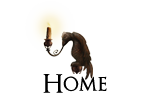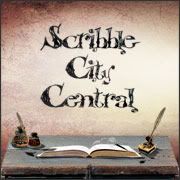Scribble City Central's thirty-ninth Fantabulous Friday comes from Anne Rooney. Anne has written literally hundreds of books for children and young adults on a myriad subjects, ranging from physics through grim, gross and grisly facts about the human body to picture books about monsters. She is also a mine of information on all sorts of esoteric subjects, an expert on Arthurian myth and a Royal Literary Fellow as well as a reviewer and journalist for the New Humanist. If I need to know about, say, hagfish vomit, I go to Anne first!
Her most recent series of books mixes an ancient vampire lord with a bunch of YouTube Generation Y teens. These short novels (written for kids who want good YA stories, but may not be particularly competent readers) start with the discovery of a body in a forest (spiked with a tent peg, naturally), and follow the lives of the six teenagers as they are drawn into the world of a centuries-old vampire lord. Some of the settings are suitably glamorous - New York, Paris - and others more unusual - Kosovo. Each book focuses on a different character, but all have one thing in common - an authentic teen voice and a gripping, page-turning story. If you know a reluctant young reader, I'd definitely recommend taking a look at these for them. Anne is a mistress of the art of research, and naturally, the world of the undead is now at her fingertips. She has no fear of them, she maintains, and trust me when I say she'll tell you everything you ever wanted to know about
V for Vampires
Bloodsucking Dead 'Uns
AR:
They grind the land like corn;
Knowing no mercy.
They rage against mankind;
They spill men’s blood like rain,
Devouring their flesh and sucking their veins.
Babylonian incantation against vampires
Everyone knows what a vampire is, right?
 |
| Vampire by Munch |
Spiky teeth, sleeps in a grave by day, rampages in a cloak by night, sporadically sucking blood from hapless victims and changing into a bat to fly up to high windows where unwary lovelies wait with bared necks. Aversion to garlic, crucifixes, stakes through the heart and frazzling sunlight. But is it true?
Hammer Horror has a lot to answer for; Bram Stoker a little more. But vampires didn’t start with Dracula, just as rubbish school dinners didn’t start with Jamie Oliver. We were scraping out tapioca into the pig-bin in the sixties, and vampires were sucking the blood out of the hapless in Mesopotamia.
The first ‘modern’ vampire story is John Polidori’s The Vampyr, started at the same horror-fest in 1816 as Frankenstein. But it was Stoker’s Dracula that propelled vampires into the limelight and secured their tenure in cinema history.
Stoker is sometimes accused of playing fast and loose with vampire culture, but he did do a great deal of research – so his deviations were informed choices. He travelled around eastern Europe interviewing the type of old peasants sitting in haunted pubs who later became extras by the dozen in vampire movies. His notebooks, recording the vampire-lore he discovered, have been published in a facsimile volume; a newly-discovered extra notebook is due to be published next year by Robson Press.
 |
| Page of Bram Stoker's Notes |
But what about the pre-Jamie Oliver – sorry, Polidori – vampire?
The dead rising again to annoy the living and suck their blood get everywhere and always have done. The quotation at the top is taken from a Babylonian stone tablet about 4,000 years old, part of an incantation against vampires. The Greeks and Romans had their versions of vampires, too, and cultures from Japan to South America have their own versions of blood-suckers.
 |
| In Ghana, the asanbosam hangs from hooked feet in a tree waiting for passing victims. |
The real trouble with vampires began with outbreaks in East Prussia in 1710 and 1721. Then there were epidemics in 1725-30 (Hungary), 1725-32 (Austrian Serbia), 1750 (East Prussia), 1755 (Silesia), 1756 (Wallachia), and Russia (1772). The best contemporary source is Dom Calmet’s treatise on vampirism, Traité sur les Apparitions des esprits et sur les vampires ou les revenans de Hongrie, de Moravie etc, 1749 (that’s the second edition). He collected all the vampire-lore he could find, and though he took a rather sceptical view, he reported it objectively. Voltaire seemed less sceptical, writing in his Dictionnaire philosophique (1764):
“These vampires were corpses, who went out of their graves at night to suck the blood of the living, either at their throats or stomachs, after which they returned to their cemeteries. The persons so sucked waned, grew pale, and fell into consumption; while the sucking corpses grew fat, got rosy, and enjoyed an excellent appetite. It was in Poland, Hungary, Silesia, Moravia, Austria, and Lorraine, that the dead made this good cheer.”
As Voltaire notes, the Habsburg empire was particularly susceptible to problematic vampires. In 1755 Empress Marie Thérèse of Austro-Hungary (mother of Marie Antoinette) commissioned her court doctor - Gerard van Swieten - to investigate. He travelled around Europe collecting reports of vampirism and eventually reported back that vampires didn’t exist.
“All the fuss doesn't come from anything else than a vain fear, a superstitious credulity, a dark and eventful imagination, simplicity and ignorance among the people.”
Abhandlung des Daseyns der Gespenster, 1768
Marie Thérèse passed a law to stop people immolating dead bodies to prevent them becoming vampires. In the backstory of Vampire Dawn, van Swieten is himself a vampire and is acting in self-interest when he makes that report.
So, how do you identify a vampire? Holes appearing in the earth above a grave is a good sign that there might be a vampire beneath. And in some places a horse won’t cross the grave of a vampire. If you dig up the grave, and the occupant is uncorrupted, possibly healthy looking and with blood around the mouth, or even ruddy-faced and bloated with blood, you probably do have a vampire problem.
If you’ve caught the vampire napping, it’s a fairly easy procedure. Staking through the heart is usually effective, preferably with ash (Russia and the Baltic states) or hawthorn (Serbia) or even oak (Silesia). Other methods include beheading, burning or, in the case of particularly persistent vampires, dismembering the corpse or removing the heart, burning it and mixing the ashes with water to feed to the vampire’s ailing victims.
Of course, prevention is better than cure, and areas plagued by vampires have a good set of preventive measures to stop the vampire coming back in the first place. If you find yourself in the position of having to bury someone you suspect might come back as a vampire, you can try any of these measures: cut off the head and put it between the feet; put a lemon in the proto-vampire’s mouth; lay a branch of hawthorn or wild rose over the corpse’s chest; bury the suspect with garlic or religious objects (such as a crucifix, rosary or holy water); spike or pin the suspect’s body or clothes to the ground; drive steel or iron needles into the heart; put hawthorn in the wannabe-vampire’s socks; shoot a bullet through the coffin; put pieces of steel over the ears and eyes, in the mouth and between the fingers; bury the body upside-down – or burn the body instead of burying it in the first place. Severing the tendons behind the knees also stops a vampire rising, presumably because it’s physically incapable of getting anywhere, and putting a sickle on the chest means the vampire will burst during transformation - as it swells, it impales itself.
Assuming you forgot to do any of that, or arrive in an area where the locals are lax in their vampire-prevention procedures, how can you deter a vampire? (You don’t have to get rid of it, you just have to dissuade it from picking on you personally.)
In some places, vampires are deterred by a mirror above the door, facing outwards. They can’t enter a house unless invited – but thereafter they can come and go as they please, so be careful who you let in. They can’t cross running water, and are deterred by seeds or sand on the ground or roof (because they are compelled to count the grains). Don’t fall into the trap of assuming you can just run around until daylight – the deadliness of sunlight to vampires is a modern innovation. The black/red cape is recent, too, dating from Hamilton Deane’s depiction of Dracula in 1924, so don’t depend on sartorial details for vampire-identification purposes.
The time-honoured way of becoming a vampire is to be bitten by one. But that’s not the only way. Slavic tradition tells that if an animal jumps over the corpse – especially a cat or dog – the corpse was in danger of returning in one form or another. A deadly wound not treated with boiling water could also turn someone to a vampire. In Russia, witches and people who rejected the Russian Orthodox Church could become vampires after death.
Romania is really vampire-central. It is, of course, the home of Dracula, and the area around the Carpathian mountains is supposedly crawling with vampires. (Although the original Dracula, Vlad Tepes (Vlad the Impaler) was ruler of Romania, he had no link with vampirism before the twentieth century; Stoker took his name just because it sounded good.)
Such is the enthusiasm of the Romanians for vampires that according to ethnologist Tatomir Vukanović they even fear vampire fruit, vegetables and inanimate objects such as farm implements and chairs. Any object left outside on the night of the full moon is susceptible to becoming a vampire.
“The belief in vampires of plant origin occurs among [Gypsies] who belong to the Mosl[em] faith in [Kosovo-Metohija]. According to them there are only two plants which are regarded as likely to turn into vampires: pumpkins of every kind and water-melons. And the change takes place when they are 'fighting one another.' In Podrima and Prizrenski Podgor they consider this transformation occurs if these ground fruit have been kept for more than ten days: then the gathered pumpkins stir all by themselves and make a sound like 'brrrl, brrrl, brrrl!' and begin to shake themselves. It is also believed that sometimes a trace of blood can be seen on the pumpkin, and the [Gypsies] then say it has become a vampire. These pumpkins and melons go round the houses, stables, and rooms at night, all by themselves, and do harm to people. But it is thought that they cannot do great damage to folk, so people are not very afraid of this kind of vampire.... The[y] … destroy pumpkins and melons which have become vampires ... by plunging them into a pot of boiling water, which is then poured away, the ground fruit being afterwards scrubbed by a broom and then thrown away, and the broom burned." —Tatomir Vukanović, Journal of the Gypsy Lore Society, 1957-60
(By the way, it has been suggested that some peasant decided to wind up the poor ethnologist and none of this is true.)
But vampires are all dead and buried now, right? Not necessarily. In 1892. Mercy Brown, the so-called Rhode Island vampire, was exhumed two months after death, her heart was cut out and burned and the ashes fed to her brother Edwin after her father became convinced she was draining his life. The meal of ashes-of-sister did him no good, and Edwin died two months later.
There was supposedly a nest of vampires living in Highgate Cemetery in London in the 1970s, and according to the Romanian Antena 1 TV station, villagers on the slopes of the Carpathian mountains dug a corpse from the graveyard, drove a stake through its heart, burnt the remains of the heart, mixed the ashes with water from the local well and drank it - in 2004.
When my editor at Ransom asked me to write a vampire series, I didn’t really want to fill it with supernatural spiky-toothed eternals. Which rather begs the question of why I agreed to write about vampires at all – but I wanted to see what I could with it that didn’t involve anything impossible. I went to see a professor of epidemiology at Oxford University and we came up with a plausible disease (prion-based) that could account for all the bits of vampirism I wanted to use. The result was vampires who are freaked out by religious symbols, have obsessive arithmomania (so count small things), need blood and live ten times as long as non-vampires.
Then I went about populating the world with vampires, which was great fun. I ransacked history for useful people – amongst my vampires are Louis Pasteur, Joseph Guillotin, and a very famous dead(?) singer. My older vampires have pointy teeth because they filed them for convenience. The new vampires can’t be told apart from non-vampires. They struggle with the problems of being a vampire – blood-lust is kept under control most of the time with dietary supplements, but how do you deal with not ageing, with what you are going to do with your life for the next 700 years, and with inevitable ennui of living with the same partner for hundreds of years? And what does living so long do to your character?
Vampire Dawn is a series of six short novels and a handbook for new vampires, called Blood-sucking for Beginners. I took all the traditional vampire lore, working from Calmet’s treatise, Stoker’s notebooks and some nineteenth and early twentieth century academic texts on vampirism, and dealt with all of it. But they don’t shrivel at dawn, they do have reflections and they don’t glitter in sunlight. I love my vampires – even the evil ones. And I don’t think they are going to lie down and die after one series.
SCC: Anne! You are a genius. I thought I knew a lot about vampires, but there's stuff in your piece that's new to me. I really do hope the Vampire Dawners aren't going to lie down and die - there's so much well... life... in them. I'm sure people will be referring back to this post for a very long time, so thank you!
You can buy Anne's first Vampire Dawn book HERE
Next week: Curtis Jobling, master of shapeshifters introduces a variety of W for Weres. See you then.




















3 comments:
Great post, Anne! And - who would would have thought that Sesame Street would have got it so right? "I am the Count and I love to count!"
Loved this. Vampire pumpkins!
And anything left outside at the full moon can become a vampire? Vampire cars and bicycles, vampire flower-pots and spades... A child's dolly, left overnight in the sandpit. Vampire moggies.
Great stuff! And if you want to know more about the Vampire Dawn books, here's a link to my blog review of themhttp://bookmavenmary.blogspot.co.uk/2012/05/new-dawn-for-vampires.html
Post a Comment